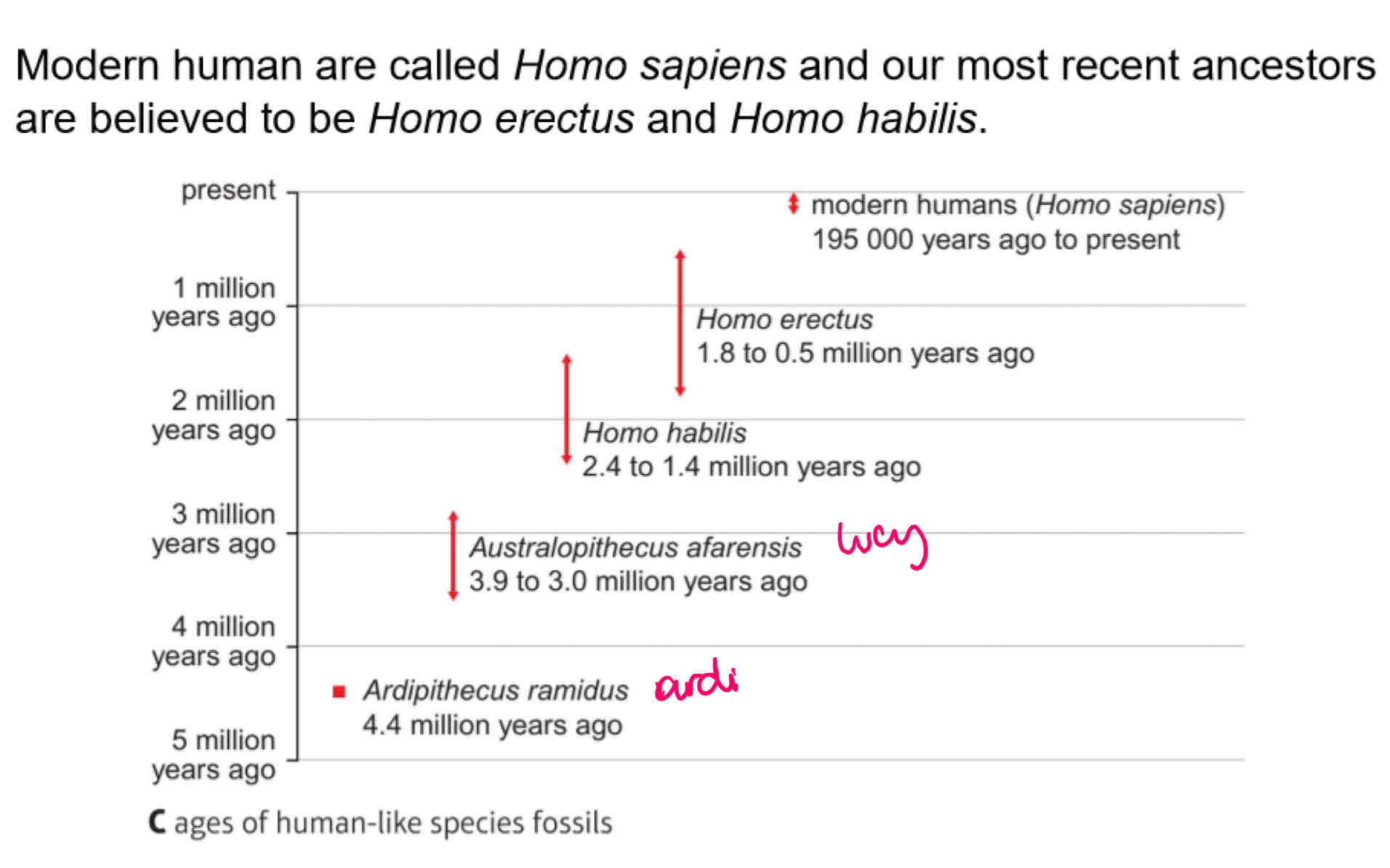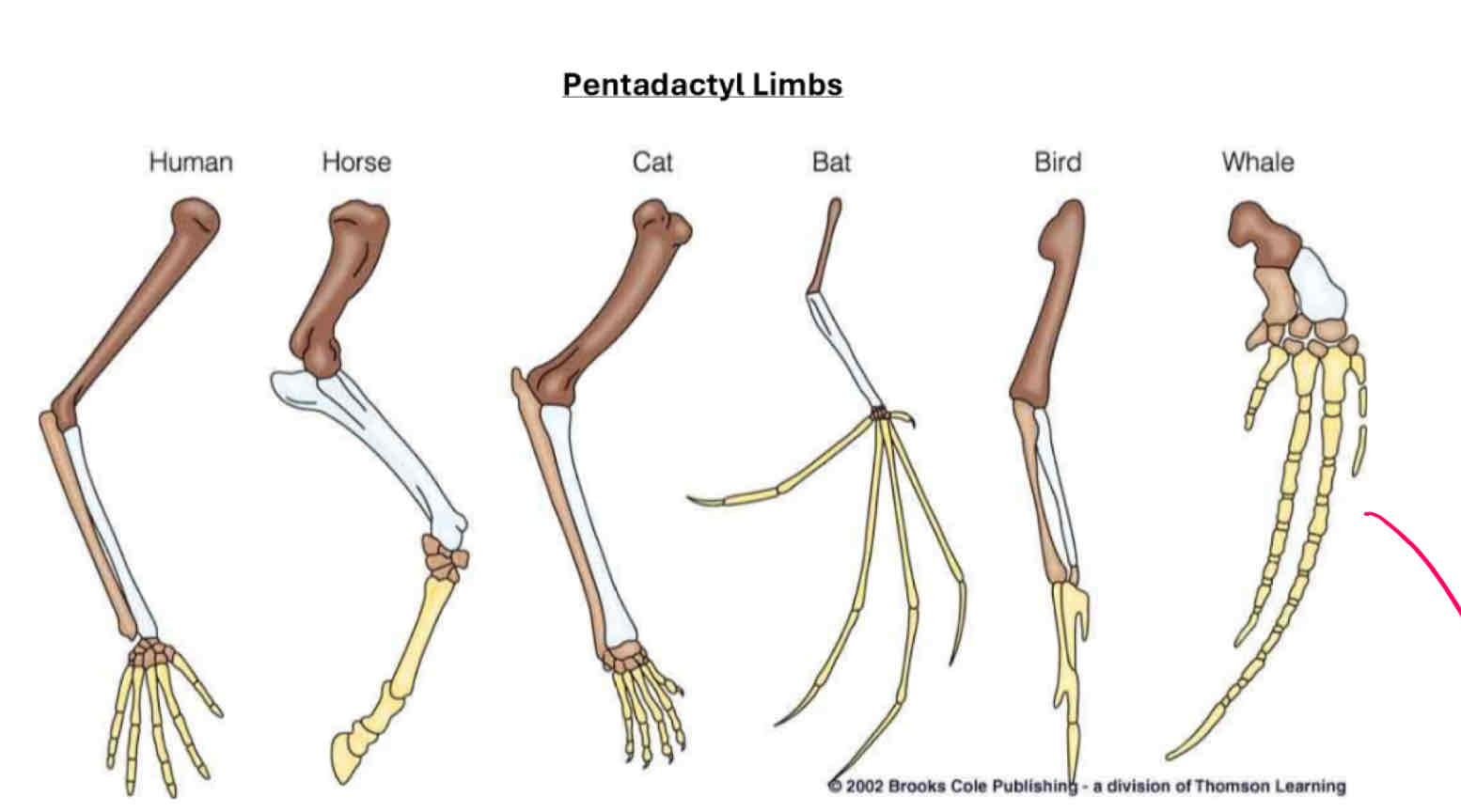Topic 4: Human evolution + Darwin theory (a-c)
1/32
Earn XP
Description and Tags
Name | Mastery | Learn | Test | Matching | Spaced |
|---|
No study sessions yet.
33 Terms
What is a disadvantage for fossil records for humans?
The fossils do not show smooth changes over time because of gaps in the fossil records
When was Ardi discovered?
1992
What features did Ardi have?
-4.4 million years ago
-Exhibited bipedalism (able to stand on two legs), with some primitive features
-Very long arms
When was Lucy discovered?
In 1974
What are Lucy’s key features?
-3.9 to 2.9 million years ago
-bipedal (able to walk upright)
-small canine teeth
-similar feet to modern humans
-lived in social groups
-omnivores
What are modern humans called?
Homo sapiens
What time were homo erectus alive?
1.8 to 0.5 million years ago
How long ago were homo habilis alive?
2.4 million to 1.4 million years ago
How long ago were Australopithecus afarensis alive?
3.9 to 3.0 million years ago
What are the key features of homo erectus ?
-lived in large social groups
-communicated
-walked upright
-mastery of tools
-advancement in technology (tools)
What are the key features of homo habilis?
-varied diet
-increase in brain size
-used simple stone tools
-lived in social groups
-had larger skulls
What evidence can be used to show that species become more intelligent and sophisticated as they evolved into modern humans?
Increased size of skull/ use of tools
What does evolution mean?
Change over time
What is the binomial name of modern humans?
Homo sapiens
How is the age of stone tools worked out?
Layer of rock
Draw a timeline of human evolution

Who was Darwin?
A naturalist and geologist
Where did Darwin travel to on HMS Beagle?
The Galapagos Islands
What did Darwin do whilst abroad HMD Beager?
Studied plant and animal samples
Name the mechanism by which evolution works, suggested by Darwin?
Natural selection
Suggest why Darwin was reluctant to publish his ideas on natural selection?
Because it challenged religious ideas
Who was Wallace?
He also came up with the idea of natural selection at the same time, but Darwin was the first one to publish
What is natural selection?
A mechanism by which new species arise. Only the organisms best adapted to their environment will survive to breed and pass on their characteristics
What is evolution?
Gradual changes in the range of organisms on the Earth. New species continually arise from species that already exist, and other species become extinct
What are the 5 steps involved in natural selection?
1) There is overproduction of offspring which lead to competition between individuals
2) Genetic variation between species
3) Some individuals will have characteristics making them better adapted to their environment than others
4) These individuals will be more likely to survive
5) The genes for these useful characteristics will be passed on to the next generation
What did Darwin observe about finches on the Galápagos Islands?
-on each island the habitats were slightly different. E.g different food sources/ shapes and sizes of seeds
-the finches were competing for food (seeds)
-the finches had slightly different beak sizes and shapes and the finches that were best adapted for the seeds on that island were able to feed successfully and survive.
Explain antibiotic resistance in terms of natural selection
-A person takes antibiotic, which kills all susceptible bacteria
-Mutation during reproduction can result in new genes , such as the gene for antibiotic resistance. This creates a new strain
-Chance of mutation gives a bacterium resistance to an antibiotic
-resistant bacterium has a selective advantage, will survive and multiply (passing on resistant alleles), in greater numbers than the non-resistance types. The resistant bacteria is able to do this because there is very little competition
-over a number of generations, the population of bacteria would become almost entirely made up of resistant types
Why does natural selection act so quickly in the case of bacteria?
The generation time of bacteria can be as short as 20 mins, meaning that there can be 72 generations in a single day
What are the 6 Pentadactyl limbs?

What is adaptive radiation?
It is the evolution (from a common ancestor) of a group of plants into a wide variety of types/ forms adapted to specialised modes of life (in a relatively short time)
How does the vertebrate pentadactyl limb provide evidence for evolution?
Amphibians, reptiles, birds, and mammals all have the same basic bone structure (the pentadactyl limb), suggesting a common ancestry.
However over time as organisms have adapted to their surroundings due to natural selection, the pentadactyl limb has adapted to suit different types of locomotion/ purposes, such a s walking, swimming, flying or digging
Both Darwin and Wallace got their idea for how evolution occurred by reading an essay. Who was the author of this essay?
Thomas Malthus